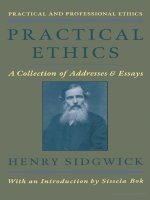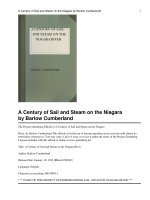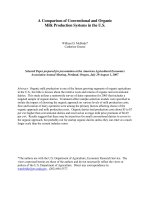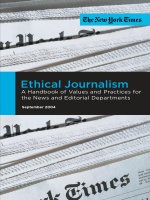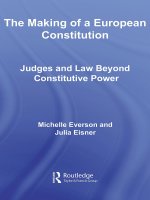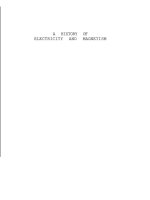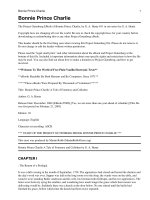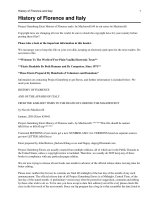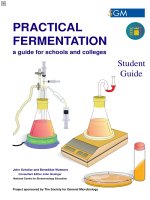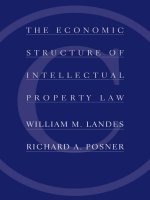A CONVERGENCE OF SCIENCE AND LAW pot
Bạn đang xem bản rút gọn của tài liệu. Xem và tải ngay bản đầy đủ của tài liệu tại đây (193.79 KB, 37 trang )
A CONVERGENCE OF
SCIENCE AND LAW
A SUMMARY REPORT OF THE FIRST
MEETING OF THE SCIENCE,
TECHNOLOGY, AND LAW PANEL
Policy and Global Affairs
NATIONAL ACADEMY PRESS
Washington, D.C.
NATIONAL ACADEMY PRESS 2101 Constitution Avenue, N.W. Washington, D.C. 20418
NOTICE: The project that is the subject of this report was approved by the Governing Board
of the National Research Council, whose members are drawn from the councils of the
National Academy of Sciences, the National Academy of Engineering, and the Institute of
Medicine. The members of the committee responsible for the report were chosen for their
special competences and with regard for appropriate balance.
This report was supported by a gift from Warren L. and Eloise Batts Family Fund. Any
opinions, findings, conclusions, or recommendations expressed in this publication are those
of the author(s) and do not necessarily reflect the views of the organizations or agencies that
provided support for the project.
International Standard Book Number 0-309-07584-X
Additional copies of this report are available from National Academy Press, 2101 Constitution
Avenue, N.W., Lockbox 285, Washington, D.C. 20055; (800) 624-6242 or (202) 334-3313 (in
the Washington metropolitan area); Internet,
Printed in the United States of America
Copyright 2001 by the National Academy of Sciences. All rights reserved.
The National Academy of Sciences is a private, nonprofit, self-perpetuating
society of distinguished scholars engaged in scientific and engineering research,
dedicated to the furtherance of science and technology and to their use for the
general welfare. Upon the authority of the charter granted to it by the Congress in
1863, the Academy has a mandate that requires it to advise the federal govern-
ment on scientific and technical matters. Dr. Bruce M. Alberts is president of the
National Academy of Sciences.
The National Academy of Engineering was established in 1964, under the charter
of the National Academy of Sciences, as a parallel organization of outstanding
engineers. It is autonomous in its administration and in the selection of its
members, sharing with the National Academy of Sciences the responsibility for
advising the federal government. The National Academy of Engineering also
sponsors engineering programs aimed at meeting national needs, encourages
education and research, and recognizes the superior achievements of engineers.
Dr. William A. Wulf is president of the National Academy of Engineering.
The Institute of Medicine was established in 1970 by the National Academy of
Sciences to secure the services of eminent members of appropriate professions in
the examination of policy matters pertaining to the health of the public. The
Institute acts under the responsibility given to the National Academy of Sciences
by its congressional charter to be an adviser to the federal government and, upon
its own initiative, to identify issues of medical care, research, and education.
Dr. Kenneth I. Shine is president of the Institute of Medicine.
The National Research Council was organized by the National Academy of
Sciences in 1916 to associate the broad community of science and technology with
the Academy’s purposes of furthering knowledge and advising the federal gov-
ernment. Functioning in accordance with general policies determined by the
Academy, the Council has become the principal operating agency of both the
National Academy of Sciences and the National Academy of Engineering in pro-
viding services to the government, the public, and the scientific and engineering
communities. The Council is administered jointly by both Academies and the
Institute of Medicine. Dr. Bruce M. Alberts and Dr. William A. Wulf are chairman
and vice chairman, respectively, of the National Research Council.
National Academy of Sciences
National Academy of Engineering
Institute of Medicine
National Research Council
v
SCIENCE, TECHNOLOGY, AND LAW PANEL
DONALD KENNEDY, Co-Chair, (NAS/IOM), Editor-in-Chief, Science;
Bing Professor of Environmental Studies, co-director, Center for
Environmental Science and Policy, Institute for International
Studies, and President Emeritus, Stanford University, Palo Alto,
California
RICHARD A. MERRILL, Co-Chair, (IOM), Daniel Caplin Professor of
Law and Sullivan & Cromwell Research Professor of Law,
University of Virginia Law School, Charlottesville, Virginia
FREDERICK R. ANDERSON, Partner, Cadwalader, Wickersham &
Taft, Washington, D.C.
MARGARET A. BERGER, Suzanne J. and Norman Miles Professor of
Law, Brooklyn Law School, Brooklyn, New York
PAUL D. CARRINGTON, Harry R. Chadwick Senior Professor, Duke
University Law School, Durham, North Carolina
JOE S. CECIL, Project Director, Program on Scientific and Technical
Evidence, Division of Research, Federal Judicial Center,
Washington, D.C.
JOEL E. COHEN, (NAS), Abby Rockefeller Mauze Professor and Head,
Laboratory of Populations, The Rockefeller University and
Professor of Populations, Columbia University, New York, New
York
REBECCA S. EISENBERG, Professor of Law, University of Michigan
Law School, Ann Arbor, Michigan
DAVID L. GOODSTEIN, Vice Provost and Professor of Physics and
Applied Physics, California Institute of Technology, Pasadena,
California
BARBARA S. HULKA, (IOM), Kenan Professor, Department of
Epidemiology, School of Public Health, University of North
Carolina, Chapel Hill, North Carolina
DANIEL J. KEVLES, Koepfli Professor of Humanities and Director of
the Program in Science, Ethics, and Public Policy at the California
Institute of Technology, Pasadena, California
DAVID KORN, (IOM), Senior Vice President for Biomedical and
Health Sciences Research, Association of American Medical
Colleges, Washington, D.C.
ERIC S. LANDER, (NAS/IOM), Member, Whitehead Institute for
Biomedical Research, Professor of Biology, Massachusetts Institute
of Technology (MIT), Director, Whitehead Institute/MIT Center for
Genome Research, and Geneticist, Massachusetts General Hospital,
MIT, Cambridge, Massachusetts
vi
PATRICK A. MALONE, Partner, Stein, Mitchell & Mezines,
Washington, D.C.
RICHARD A. MESERVE, Chairman, Nuclear Regulatory Commission,
Washington, D.C.
ALAN B. MORRISON, Director, Public Citizen Litigation Group,
Washington, D.C.
HARRY J. PEARCE, Chairman, Hughes Electronic Corporation,
El Segundo, California
HENRY PETROSKI, (NAE), A.S. Vesic Professor of Civil Engineering
and Professor of History, Duke University, Durham, North Carolina
CHANNING R. ROBERTSON, Ruth G. and William K. Bowes
Professor, School of Engineering, and Professor, Department of
Chemical Engineering, Stanford University, Palo Alto, California
PAMELA ANN RYMER, Circuit Judge, U.S. Court of Appeals for the
Ninth Circuit, Pasadena, California
STAFF OF THE SCIENCE, TECHNOLOGY, AND LAW PROGRAM
ANNE-MARIE MAZZA, Director
SUSIE BACHTEL, Staff Associate
MAARIKA LIIVAK, Christine Mizrayan Intern
DUNCAN BROWN, Consultant
vii
The Science, Technology, and Law Panel wishes to acknowledge the
many fine contributions of the speakers attending the first meeting of the
Panel. We especially wish to thank Arthur Bienenstock, Associate Direc-
tor for Science, White House Office of Science and Technology Policy;
Bert Black, partner, Hughes & Luce, and co-chair, ABA-AAAS National
Conference of Lawyers and Scientists; Lloyd Dixon, Project Director,
RAND; Donald M. Kerr, Assistant Director, Laboratory Division, Federal
Bureau of Investigation; Donald Prosnitz, Chief Science and Technology
Advisor, U.S. Department of Justice; and Fern Smith, Director, Federal
Judicial Center and Judge, U.S. District Court for the Northern District of
California.
This report has been reviewed in draft form by individuals chosen for
their diverse perspectives and technical expertise in accordance with pro-
cedures approved by the NRC’s Report Review Committee. The purpose
of this independent review is to provide candid and critical comments
that will assist the institution in making its published report as sound as
possible and to ensure that the report meets institutional standards for
objectivity, evidence, and responsiveness to the study charge. The review
comments and draft manuscript remain confidential to protect the integ-
rity of the deliberative process.
We wish to thank the following individuals for their review of this
report: Honorable Danny J. Boggs, U.S. Court of Appeals for the Sixth
Circuit; Carl Cranor, University of California-Riverside; Bernard D.
Goldstein, The University of Medicine and Dentistry of New Jersey-Robert
Acknowledgments
viii ACKNOWLEDGMENTS
Wood Johnson Medical School; Honorable Pauline Newman, U.S. Court
of Appeals, Federal Circuit; Anthony Z. Roisman, Hershenson, Carter,
Scott & McGee; and Nathan A. Schactman, McCarter & English.
Although the reviewers listed above have provided many construc-
tive comments and suggestions, they were not asked to endorse the report
nor did they see the final draft of the report before its release. The review
of this report was overseen by Harold Forsen appointed by the NRC’s
Report Review Committee, who was responsible for making certain that
an independent examination of this report was carried out in accordance
with institutional procedures and that all review comments were care-
fully considered. Responsibility for the final content of this report rests
entirely with the authoring committee and the institution.
In addition, the Panel wishes to acknowledge the work of the Science,
Technology, and Law Program staff: Anne-Marie Mazza; Susie Bachtel;
Maarika Liivak; and consultant writer Duncan Brown.
ix
1 INTRODUCTION 1
Recent Developments, 2
Formation of the Science, Technology, and Law Program, 3
Organization of this Report, 4
2 SCIENTIFIC AND TECHNICAL EVIDENCE IN THE 5
COURTROOM
The Supreme Court Trilogy, 5
Implications of the Trilogy for Judges, Juries, and Experts, 7
For Judges, 7
For Juries, 10
For Experts, 10
3 LAW AND THE CONDUCT OF SCIENTIFIC AND 12
ENGINEERING ACTIVITIES
Access to Research Data, 12
Public Access to Federally Funded Research Data that
Underlies Regulation, 13
Court-Ordered Disclosure of Academic Research, 15
Conflicts Between Intellectual Property Rights and
Openness of Research, 15
The Patenting of Research Tools, 15
The Tighter Restrictions on Publication, 16
Quasi-Judicial Proceedings in Research Misconduct Cases, 16
Contents
x CONTENTS
4 SCIENCE, TECHNOLOGY, AND LAW PANEL’S AGENDA 18
BIBLIOGRAPHY 20
BIOGRAPHICAL INFORMATION 22
Science, Technology, and Law Panel, 22
Staff of the Science, Technology, and Law Panel, 26
1
This report is a summary of the first meeting of the Science, Technology,
and Law Panel of The National Academies, convened on March 16-17,
2000, at the Beckman Center in Irvine, California. The Science, Tech-
nology, and Law (STL) Program was established to monitor and explore
the growing number of areas in which the processes of legal decision
making utilize or impinge on the work of scientists and engineers. One of
the major activities of the STL Program is convening a distinguished panel
of individuals drawn from both the science and engineering and legal
communities. The purpose of the Panel’s first meeting was to share infor-
mation about a number of areas in which science and law interact so that
all the members of the Panel, with their different backgrounds, would be
in a better position to determine the Panel’s future agenda.
The principles of science and law developed over the centuries in
response to their differing objects of interest. Science, engineering, and
technology seek knowledge through an open-ended search for expanded
understanding, whose “truths” are subject to revision. Law, too, conducts
an open-ended search for expanded understanding; however, it demands
definite findings of fact at given points in time. When these two disci-
plines meet in the courtroom the differences between the two cultures are
magnified. For example, the legal tradition of adversarial proceedings
contrasts with the cooperative ethic of science. Even the search for truth
does not serve the same aims and may not be subject to the same
constraints and requirements. Simply stated, science, engineering, and
1
Introduction
2 A CONVERGENCE OF SCIENCE AND LAW
technology
1
aim to understand, predict, modify, and control aspects of
the natural and manufactured world, while the law seeks current truth
about scientific and other facts of cases in order to serve the much differ-
ent goal of justice between parties (as well as other societal goals).
In today’s high-technology society the two professions are increas-
ingly often forced to interact in legal disputes involving patents, product
liability, environmental torts, regulatory proceedings, and criminal cases.
Further, law and science encounter each other in the laboratory through a
number of federal actions governing intellectual property, research mis-
conduct, access to research data, and conflicts of interest. The fact-finding
agendas of the two disciplines now frequently have begun to overlap, if
not merge. Because there is a general lack of understanding of each cul-
ture, these interactions often lead to a cognitive friction that is both dis-
turbing and costly to society.
As was noted throughout the meeting, scientists tend to be leery of
lawyers and the legal process, preferring not to venture into the court-
room. Lawyers are often frustrated by a scientific community that believes
that its methods and procedures are above legal scrutiny and question-
ing. Lawyers and scientists may seldom speak the same language, but it
should be possible for each to develop a better understanding of the prin-
ciples and methods of the other’s profession. Bridging this divide will be
a challenge for the STL program as it attempts to build a better under-
standing between the two communities.
RECENT DEVELOPMENTS
Several events in the past decade have significantly increased the
tension at the interface of science and law. First, scientific and technical
evidence is more frequently presented in litigation and has become more
complex. Judges indicate that the number of cases involving scientific
and technical information has increased significantly. Such proceedings
often attempt to resolve issues that scientists and engineers view as within
their domain (for example, whether or not breast implants cause auto-
immune disease). The recent Daubert, Joiner, and Kumho decisions of the
Supreme Court
2
demand an active “gatekeeping” role for judges in assess-
ing expert testimony, requiring them to take account of professional prac-
tices outside the courtroom.
1
Throughout this report, science will be used to include science, engineering, and
technology.
2
Daubert v. Merrell Dow Pharmaceuticals, 509 U.S. 579 (1993); General Electric Co. v. Joiner,
522 U.S. 136 (1997); Kumho Tire Co. v. Carmichael, 199 S. Ct. 1167 (1999).
INTRODUCTION 3
Second, health, safety, and environmental regulations are more fre-
quently based on epidemiology, ecological modeling, and other statistical
methodologies, and are intended to address risks that incorporate assump-
tions that may be difficult to verify. Parties affected by such regulations
often challenge the scientific foundations of these rules, opening up for
public review the internal process of the underlying science.
Third, the legal doctrines defining intellectual property have become
increasingly prominent in the past two decades. New industries have
arisen to exploit fundamental science, most notably in molecular biology.
These advances have presented new challenges to the patent system. In
response to the Bayh-Dole and Stevenson-Wydler Acts and related mea-
sures to encourage nonprofit institutions to transfer technology to indus-
try, academic institutions and other nonprofit research organizations also
have grown more interested in patenting new knowledge. The number of
patents is rising rapidly; approximately 160,000 were granted in 1999, up
from 100,000 a decade earlier (Barton, 2000). Federal courts are called
upon to rule on a number of highly sophisticated scientific and technical
issues in patent infringement cases.
Finally, in a number of ways legal decisions are a part of every
scientist’s and engineer’s daily existence. Laws and regulations govern-
ing intellectual property, access to research data, research misconduct,
and grants and contracts are a few examples. Just as science and engi-
neering are increasingly present in the courtroom, legal decisions are
having a more prevalent affect on how scientists and engineers conduct
their research and design activities.
FORMATION OF THE SCIENCE, TECHNOLOGY,
AND LAW PROGRAM
For several years The National Academies explored the notion of a
new program to study the interactions of science, technology, and law.
Serious discussion dates from spring 1996, when Supreme Court Associ-
ate Justice Stephen G. Breyer discussed the idea in an informal dinner
with leaders of The National Academies. That discussion led to a day-
long symposium in November 1997, at which a group of knowledgeable
scientists, engineers, judges, lawyers, business executives, and govern-
ment officials discussed possible roles for The National Academies in
this area.
During the 1990s The National Academies submitted amicus curiae
briefs to the Supreme Court in two of the three earlier mentioned cases
involving significant issues at the boundaries of science and law. In Janu-
ary 1993, the National Academy of Sciences (NAS) and the American
Association for the Advancement of Science (AAAS) joined in an amicus
4 A CONVERGENCE OF SCIENCE AND LAW
curiae brief in support of the respondent, Merrell Dow Pharmaceuticals,
in Daubert v. Merrell Dow Pharmaceuticals, Inc. The National Academy of
Engineering (NAE) in August 1998 submitted a brief in support of the
petitioners in Kumho Tire Company v. Carmichael. The need for scientists
participation in the legal arena was evident when Associate Justice Breyer
addressed the 150th Annual Meeting of the AAAS in February 1998, say-
ing “In this age of science we must build legal foundations that are sound
in science as well as in law.”
To continue exploration of these opportunities The National Acad-
emies established the Science, Technology, and Law (STL) Program. A
major activity for the program is to convene a distinguished panel. The
Panel was duly formed and held its first meeting on March 16–17, 2000.
The Panel’s desire is to establish a regular dialogue between the science
and engineering community and the legal community to study pressing
issues, improve communication, and help resolve disagreements.
ORGANIZATION OF THIS REPORT
Following this introductory chapter, this report summarizes the
Panel’s initial meeting and its future agenda. Chapter Two reviews issues
arising as a result of three Supreme Court decisions regarding admissibil-
ity of expert testimony. During its deliberations the Panel considered a
number of measures that might help judges, juries, and expert witnesses
in the courtroom.
Chapter Three discusses the effect of law on the conduct of scientific
and engineering activities. In particular, it reviews the impact of recent
legal, legislative, and regulatory developments on ownership rights to
research data. Some observers contend that permitting greatly expanded
access to research data that is still under way by those who seek to influ-
ence decisions of courts and regulatory agencies will hinder the research
enterprise and will impose excessive burdens on researchers. Others
argue that the public has a right to the data generated by federal funds. In
addition, this chapter discusses intellectual property and the new federal
policy for research misconduct. Chapter Four summarizes the STL
program’s agenda for future activities.
5
During its first day and into the morning session of the second day,
the Panel reviewed three Supreme Court cases dealing with the admissi-
bility of expert evidence and the implications of these cases for judges,
juries, and expert witnesses. Complicated questions of fact increasingly
demand scientific and technical judgments by jurists, juries, and lawyers,
who are usually not well prepared by education or experience to make
such decisions. These deliberations are summarized below.
THE SUPREME COURT TRILOGY
The law of expert evidence has changed substantially in the past de-
cade as the result of three Supreme Court decisions. In 1993, the Frye
rule
3
for determining admissibility of expert testimony gave way after
nearly 70 years to the Daubert criterion of scientific reasoning and meth-
odology. Frye looked to the scientific community for guidance, allowing
judges to admit testimony if the theory underlying the expert’s opinion
had “gained general acceptance in the particular field in which it belongs.”
The first case in the trilogy, Daubert v. Merrell Dow Pharmaceuticals,
Inc., is a 1993 case involving birth defects alleged to have resulted from a
mother’s use of Bendectin, a morning sickness remedy. In this case, the
Supreme Court established a test for the admissibility of scientific evi-
2
Scientific and Technical Evidence
in the Courtroom
3
Frye v. United States, 293 F. 1013 (D.C. Circuit, 1923).
6 A CONVERGENCE OF SCIENCE AND LAW
dence that required that the testimony not only to be relevant to the facts
of the case, but also to be reliable. The new admissibility test requires
judicial assessment of “whether the reasoning or methodology underlying
the testimony is scientifically valid and of whether the reasoning or meth-
odology properly can be applied to the facts in issue.” To meet the reli-
ability test, the testimony must be the result of scientific reasoning and
methodology evidenced by four factors:
1. whether the theory can be tested;
2. whether the theory has been published in a peer-review publication;
3. whether there exists known or potential error rates; and
4. whether there are standards for controlling the technique’s execution.
In specifying these factors, the Supreme Court gave the trial judge
responsibility for assessing the soundness of the scientific information
and reasoning that an expert witness presents in court. In so doing, the
Supreme Court assigned the role of “gatekeeper” to the trial judge, requir-
ing that the judge screen expert testimony to determine both its relevance
and reliability while respecting the role of the jury to resolve disputed
factual issues.
The second case in the trilogy, General Electric v. Joiner, a toxic tort case
in which the plaintiff alleged that his lung cancer was a result of his
exposure to polychlorinated biphenyls (PCBs), is a case in which the trial
judge applied the Daubert criteria, excluded the testimony, and granted
summary judgment. The appellate court reversed and set the stage for
the Supreme Court’s consideration. In Joiner, the Supreme Court held
that the appellate courts, when reviewing a lower court’s decision admit-
ting or excluding expert testimony, must use an abuse of discretion stan-
dard that requires deference to the trial judge’s ruling. The Supreme
Court then went further, reviewing the evidence and finding that the trial
judge had not abused her discretion in excluding testimony, since the
expert failed to adequately relate his testimony in the case to the scientific
studies on which he had relied.
The third case in the trilogy, Kumho Tire Co. v. Carmichael, is a product
liability case in which the plaintiff claimed that a tire on his vehicle blew
out as a result of a defect. In this 1999 case, the Supreme Court extended
the trial judge’s gatekeeper obligation to all expert testimony, not just
purely scientific testimony. The Court “concluded that Daubert’s general
holding—setting forth the trial judge’s general ‘gatekeeping’ obligation—
applies not only to testimony based on ‘scientific’ knowledge, but also to
testimony based on ’technical’ and ‘other specialized’ knowledge.” The
Court declared that the expert in the courtroom must employ “the same
SCIENTIFIC AND TECHNICAL EVIDENCE IN THE COURTROOM 7
level of intellectual rigor that characterizes the practice of an expert in the
relevant field.”
4
In response to the Supreme Court’s trilogy on expert proof, Rule 702
of the Federal Rules of Evidence (“Testimony by Experts”) was amended
in 2000. The rule now states that [additions underscored], “If scientific,
technical, or other specialized knowledge will assist the trier of fact to
understand the evidence or to determine a fact in issue, a witness quali-
fied as an expert by knowledge, skill, experience, training, or education,
may testify thereto in the form of an opinion or otherwise if (1) the testi-
mony is based upon sufficient facts or data, (2) the testimony is the prod-
uct of reliable principles and methods, and (3) the witness has applied the
principles and methods reliably to the facts of the case.”
Implications of the Trilogy for Judges, Juries, and Experts
As a result of these decisions and the amended rules, the STL Panel
was interested in knowing how the legal system is responding, what the
implications of these decisions are for the key players in litigation (judge,
juror, and expert) and what mechanisms would help these players fulfill
their responsibilities in court. The STL Panel discussed a number of
mechanisms to help courts deal more effectively with scientific and
technical evidence. Many of these approaches, such as court-appointed
experts, are controversial and most are fraught with complexities. Exist-
ing and proposed remedies are discussed below.
For Judges
It was noted that judges have little spare time for in-depth study of
science or engineering. Nonetheless, in today’s courtroom, they need
intensive, focused information and educational tools to help them under-
stand the scientific and technical basis of expert testimony.
Special Masters. Judges currently may appoint special masters in certain
exceptional cases. These officials are generally experts on the law, but
sometimes they have specialized scientific or technical expertise. The
powers and duties of the special master vary widely. They may include
supervising the discovery of evidence, preparing reports for consider-
ation by the judge or jury, or overseeing expert depositions.
4
While the focus in this discussion is on civil litigation, these three Supreme Court
decisions similarly affect criminal litigation as judges rule on the admissibility of forensic
science.
8 A CONVERGENCE OF SCIENCE AND LAW
Court-Appointed Witnesses. Under Rule 706 of the Federal Rules of
Evidence, a judge may appoint an expert witness, or even a panel of
witnesses, of his own choosing. Such a witness may be asked to report on
a particular scientific or technical issue for the case, and is then deposed
by both parties as part of the discovery process. The federal judge over-
seeing most of the federal cases involving silicone gel breast implants, for
example, appointed a four-member scientific panel to prepare a report on
the scientific basis of competing claims made by the parties. The Panel
was appointed with the approval of both the plaintiffs’ and the defen-
dants’ counsel. Its costs were defrayed by the Administrative Office.
Over the course of 2 years, the Panel reviewed relevant scientific litera-
ture, produced a report, and was deposed. Special counsel were retained
to represent the Panel. (See Hulka et al., 2000.)
One experiment in making independent experts more conveniently
available to judges is the recently launched Court Appointed Scientific
Experts (CASE) demonstration project of the Scientific Freedom, Respon-
sibility and Law Program of the AAAS. As part of the project, judges
wishing to appoint experts may call on CASE staff for help in identifying
highly qualified scientists and engineers to serve as experts to the courts,
rather than to the parties in litigation. CASE staff use several methods to
identify suitable experts, including requesting help from professional and
scientific societies and institutions. A CASE Recruitment and Screening
Panel composed of respected scientists and engineers screen and recruit
experts. Subcommittees will prepare educational and resource materials
for courts and for the scientists and engineers identified as prospective
experts, and will advise on such matters as conflicts of interest. An advi-
sory committee (chaired by a federal appeals court judge) oversees the
project. The Federal Judicial Center (the research and education arm of
the federal judiciary) will evaluate CASE.
The Private Adjudication Center, Inc., of Duke University School of
Law also maintains a registry of independent scientific and technical
experts who are willing to provide advice to courts or serve as court-
appointed experts. In addition, the Federal Judicial Center offers a series
of programs to acquaint judges with scientific principles and evidentiary
standards used to evaluate the admissibility of technical proof.
Technical Advisors. Some suggested that judges should have established
sources of technical and scientific information, who could be called upon
not to serve as witnesses, but as tutors. A roster of such individuals who
could explain difficult technical aspects of cases, for example, those that
might involve advanced statistics or the chemistry of gene expression,
could provide assistance to judges.
SCIENTIFIC AND TECHNICAL EVIDENCE IN THE COURTROOM 9
Video, Print, or Online Summaries. The Internet provides new opportu-
nities for “learning on demand” or “just-in-time learning” that could pro-
vide judges with access to scientific and engineering materials over the
course of a case. In theory, a judge might also be able to visit an Internet
site covering a scientific or engineering topic, and then navigate by hyper-
link through a great mass of authoritative information.
In practice, however, developing such materials is not a trivial task.
Such materials must be prepared and reviewed by both scientific and
legal communities to ensure that they are not only accurate and represent
the consensus of the field, but are without bias. Sources able to provide
funding for such materials are not readily identifiable.
Short Courses. A number of academic institutions host brief summer
sessions to help judges understand the role of science and technology in
the courtroom. These include the Program in Judging Science of Duke
University’s Private Adjudication Center; the University of Virginia’s
Graduate Program for Judges; and various courses at the National Judi-
cial College. However, attendance at these sessions tends to be sparse,
due to competing demands on judges’ time and the scarcity of funds in
court budgets.
Specialized Courts. Specialized courts have been proposed as a way to
help courts deal more effectively with scientific and technical evidence
(see, for example, Kantrowitz, 1967). However, today federal judges are
normally assigned cases by lot, not on their expertise. Some particularly
complex or broadly significant cases may be aggregated regionally or
nationally for limited purposes as authorized by statute, as occurred with
the federal cases involving silicone gel breast implants.
Long-Term Independent Research Programs and Periodic Reviews. One
promising approach could be to conduct a series of long-term studies of
scientific topics of potential regulatory interest both to establish a basis
for consensus and at the same time give judges forewarning of emerging
scientific and technical issues. These types of studies have been used to
reduce disputes about the facts in contentious regulatory arenas includ-
ing the health effects of air pollution. For areas of science in which a long-
term view is possible, this approach might reduce some of the inevitable
conflicts over regulation. However, this approach is less applicable to the
fast-moving fields of science and technology, such as those issues arising
in the increasing number of intellectual property cases heard by federal
courts.
10 A CONVERGENCE OF SCIENCE AND LAW
For Juries
The right to a trial by a jury is guaranteed by the Constitution. The
challenges of presenting scientific and technical information to jurors are
at least as great, if not greater, as those of helping judges understand such
material. The STL Panel considered a number of approaches, discussed
below, that could improve the jury’s understanding and assessment of
scientific and technical testimony.
Providing Scientific and Technical Information. Background materials
explaining the scientific process and addressing specific scientific or tech-
nical questions could be prepared to help juries understand and assess
the pertinent facts at issue in a particular case. These materials would
have to be developed in a “just-in-time” manner.
Developing Model Jury Instructions. Jury instructions are critical sources
of information on the law and the rules of evidence. Many jurors, some
judges say, are swayed unduly by the aura of certainty that scientists and
engineers may present in court. Judges’ instructions to juries could be
formulated to help jurors better evaluate expert testimony and to focus on
the reasoning underlying the expert testimony rather than traditional
credibility assessments. A model set of instructions might, for example,
be developed to aid jurors’ understanding of probability, risk, or a par-
ticular scientific or technical question at issue.
For Experts
Several STL Panelists noted that the Daubert and Kumho decisions
shine a spotlight on the methodology and reasoning of the expert witness.
This scrutiny itself may force an improvement in the quality of testimony
that experts offer. The STL Panel discussed several other ways to improve
expert testimony.
Preparing Tutorials for Expert Witnesses. Many scientists and engineers
who are required to testify in court are unprepared for the experience.
Several different kinds of guides for experts might be useful including:
1. Ways to present information that will be useful to juries and
judges.
2. Tutorials on the legal processes of discovery and testimony.
3. Tutorials on the legal demands for confidentiality and how these
demands may constrain one’s analysis.
SCIENTIFIC AND TECHNICAL EVIDENCE IN THE COURTROOM 11
Developing Ethical Standards for Expert Witnesses. While experts who
appear in court represent the interests of particular parties, it is not clear
from a legal perspective to whom experts owe ethical obligations and
whether they are governed by the ethical standards that apply to lawyers,
to their professions, or to something more. Scientific and technical asso-
ciations could find it useful to develop or support strong codes of ethics
for members who testify as experts. Some professional associations, such
as the American Psychological Association and the American College of
Occupational and Environmental Medicine have developed standards for
conduct in the courtroom.
12
On the second day of the meeting, the STL Panel explored several
areas where law places constraints and requirements on the conduct of
academic research. Specifically, the Panel reviewed issues regarding
1) access to research data, 2) intellectual property, and 3) research
misconduct.
ACCESS TO RESEARCH DATA
The social and economic stakes of research are rising. Federal regula-
tory and policy decisions of great importance hinge more and more on
questions of cutting-edge science and technology. Traditional mecha-
nisms for conveying policy-relevant research findings permit researchers
to retain a proprietary interest in their underlying research data. How-
ever, in today’s climate a variety of legal proceedings require scientists
and engineers to justify their findings and disclose their research data and
methods in unaccustomed degrees of detail. These include the following:
• recent federal legislation gives the public the authority under the
Freedom of Information Act (FOIA) to access federally sponsored
research data
• scientists’ data are on occasion subpoenaed even in cases in which
the scientists have no involvement in the litigation.
3
Law and the Conduct of
Scientific and Engineering Activities
LAW AND THE CONDUCT OF SCIENTIFIC AND ENGINEERING ACTIVITIES 13
These proceedings represent another area where the cultures of sci-
ence and law clash. Openness and a willingness to share research data are
paramount to the scientific enterprise. For the scientific community, the
common means of ensuring accuracy and quality of research is replication.
Publication of one’s findings is the means by which scientists communi-
cate with each other and provide the information necessary for replication
and reanalysis. Most scientific journals rely on peer review to ensure that
scientific papers meet a threshold of credibility. Peer review is handled in
a decentralized way, much of it by volunteers, and coordinated by editors
of individual professional journals. While peer review is not a substitute
for replicability, it does provide the scientific community with a level of
confidence about the integrity of the research findings. In litigation, how-
ever, a lawyer, in carrying out his or her duty to represent his client, may
seek independent verification of research results. Consequently, he or
she may accord little weight to the fact that the results may have been
peer reviewed and published when questioning and challenging the ex-
pert. A vigorous attack of the expert witness and his or her research
results may be just what is needed in order to provide his or her client
with a good defense, but it may leave the expert most uneasy.
PUBLIC ACCESS TO FEDERALLY FUNDED RESEARCH DATA
THAT UNDERLIES REGULATION
The regulatory requirement of publication and notice seeks public
consensus as to the accuracy of facts and reasonableness of proposed new
rules and regulations. However, the facts may be disputed, and regula-
tors then labor under a handicap in establishing public credibility. For
example, the U.S. Environmental Protection Agency (EPA) in 1997 pro-
posed to tighten federal air quality regulations for particulate matter. The
proposed new standard was based partly on the results of the Harvard
“Six Cities” epidemiological study, which identified a correlation between
death rates and airborne particulates in several middle-sized cities. Imple-
menting these standards would cost industry billions of dollars, much of
it passed on to industry. While EPA’s action followed a typical regulatory
path, concerns about the underlying data resulted in a legislative action
that sought to change the manner in which the public gains access to
federally sponsored research data.
Industry groups (and several members of Congress) asked EPA for
the underlying research data from these studies in order to conduct their
own analysis. The Harvard researchers, funded by the National Institutes
of Health (NIH), refused to release the research data, citing privacy con-
cerns of the human subjects and the researcher’s traditional right to con-
trol data. EPA agreed with this view. As an alternative, EPA and the
14 A CONVERGENCE OF SCIENCE AND LAW
researchers offered to have the data reanalyzed by the Health Effects
Institute (HEI), an independent research institute jointly funded by indus-
try and the EPA, whose policy is set by an independent board. The results
of that study were not expected to be available, however, until 2 years
after the regulation had become final.
EPA argued that the peer review undergone by the Harvard study
was sufficient to support regulations. Critics (for example, Cohen and
Hahn, 1999) pointed out that academic peer reviews are often flawed (the
expectation is that mistakes will wash out in the long run, as other scien-
tists try to replicate the results), and that regulations costing billions of
dollars to enforce should not be built solely on such a foundation.
Meanwhile, Congress, through the Shelby amendment, directed the
Office of Management and Budget (OMB) to revise regulations covering
research grants to nonprofit organizations (OMB Circular A-110, subpart
C.36) to give the public access under FOIA to data relating to all federally
funded research. After much public discussion, OMB issued the final
rule. The final rule provides public access to “research data relating to
published research findings produced under an award that were used by
the Federal Government in developing an agency action that has the force
and effect of law.”
The rule—which applies only to nonprofit research grantees—raises
a number of questions that may lead to litigation:
1. Does the new rule apply retroactively or only prospectively?
2. What are the potential costs and administrative burdens of com-
plying with requests, and how will researchers be reimbursed?
3. How, in practice, will privacy concerns regarding research data
that involve human subjects or patient records be handled?
4. How will agencies and courts set the threshold of cost or signifi-
cance below which federal “agency actions” are not subject to this
requirement?
5. Will requests be made to harass researchers or hinder their ability
to conduct research?
As was pointed out during the STL Panel discussion, achieving the
right balance for the public good in such cases is difficult. The results of
complex statistical studies used for regulatory purposes can be subject to
various interpretations, and on these grounds deserve the widest possible
scrutiny. Traditional peer review alone may not be sufficient in such cases
to ensure credibility. On the other hand, many in the academic commu-
nity see the new OMB rule as an invasion of privacy, a potentially onerous
burden that will divert researchers from work that is of broader benefit,
and in the extreme case, view the rule as a license to harass and discour-
